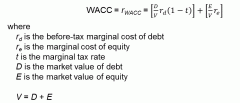![]()
![]()
![]()
Use LEFT and RIGHT arrow keys to navigate between flashcards;
Use UP and DOWN arrow keys to flip the card;
H to show hint;
A reads text to speech;
19 Cards in this Set
- Front
- Back
|
DIVIDEND AND SHARE REPURCHASES |
Stable Dividend Policy - increasing the dividend at a reasonable steady rate |
|
|
DIVIDEND AND SHARE REPURCHASES |
Div1-Div0 = target change = (target ratio * EPS1 - Div0) |
|
|
DIVIDEND AND SHARE REPURCHASES |

Difference in stock price before and after the dividend is if you own the stock and paid capital gains and paid dividend tax |
|
|
CAPITAL STRUCTURE |

WACC is the marginal cost of raising additional capital affected by the cost of capital and proportion of each capital |
|
|
CAPITAL STRUCTURE |

|
|
|
CAPITAL STRUCTURE |
Proposition I |
|
|
CAPITAL STRUCTURE |
Cash Flow After Tax = Net Income + Depreciation + Amortization + Other Non Cash Charges - Cash Charges |
|
|
CAPITAL STRUCTURE |
Sales - Cash Operating Expense - Depreciation * (1 - Tax Rate) + Depreciation |
|
|
CAPITAL STRUCTURE |
FCInv = investment in new fixed capital |
|
|
CAPITAL STRUCTURE |
1) Calculate the PV of each depreciation method |
|
|
CAPITAL STRUCTURE |
Economic Income = AT CF + (delta) project's MV |
|
|
VALUATION MODELS |
Econ. Profit = NOPAT - $WACC; discounted at WACC |
|
|
VALUATION MODEL |
Residual Income = Net Income - Equity Charge |
|
|
DIVIDEND AND SHARE REPURCHASES |
Dividend Coverage Ratio = Net Income/Dividends |
|
|
DIVIDEND AND SHARE REPURCHASES |
FCFE Coverage Ratio = FCFE / (Dividends + Share Repurchases) |
|
|
MERGERS AND ACQUISITIONS |
HHI = mkt. power = sum of squared mkt. shares |
|
|
MERGERS AND ACQUISITIONS |
V(A+T)=V(A)+V(T)+S-C |
|
|
MERGERS AND ACQUISITIONS |
Takeover Premium (to target): |
|
|
MERGERS AND ACQUISITIONS |
Gain (A) = S - TP = S - (P(T) - V(T)) |

